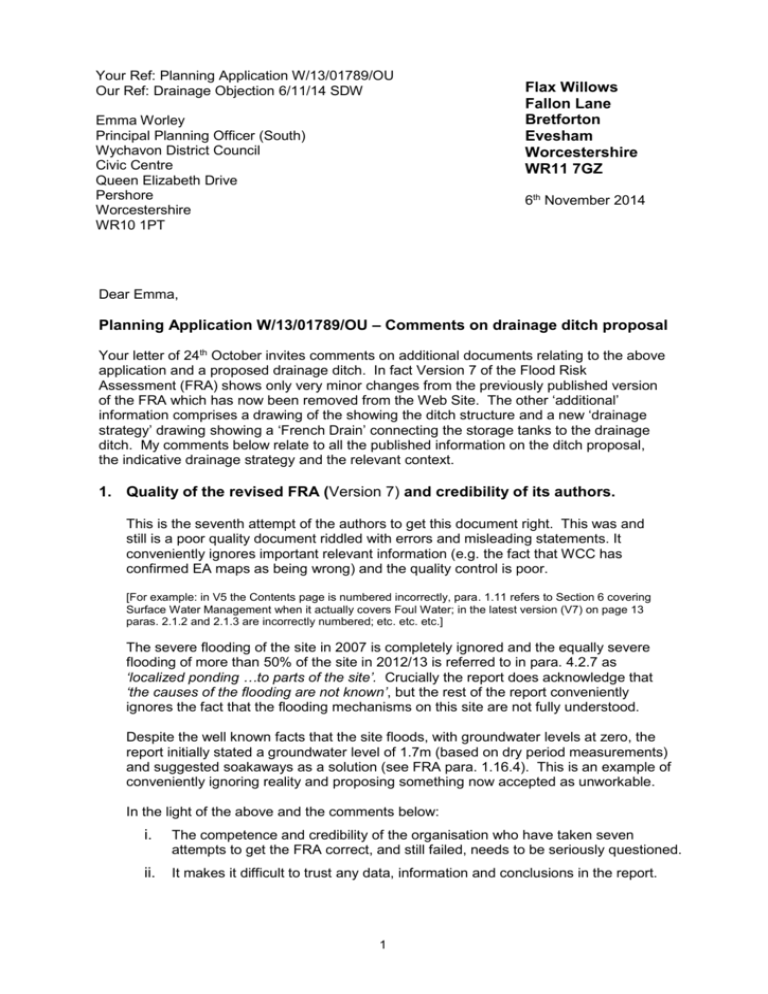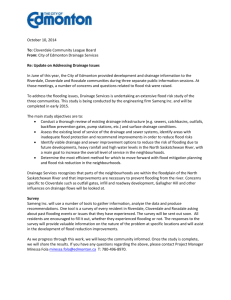Dear Emma, Planning Application W/13/01789/OU – Comments on
advertisement

Your Ref: Planning Application W/13/01789/OU Our Ref: Drainage Objection 6/11/14 SDW Emma Worley Principal Planning Officer (South) Wychavon District Council Civic Centre Queen Elizabeth Drive Pershore Worcestershire WR10 1PT Flax Willows Fallon Lane Bretforton Evesham Worcestershire WR11 7GZ 6th November 2014 Dear Emma, Planning Application W/13/01789/OU – Comments on drainage ditch proposal Your letter of 24th October invites comments on additional documents relating to the above application and a proposed drainage ditch. In fact Version 7 of the Flood Risk Assessment (FRA) shows only very minor changes from the previously published version of the FRA which has now been removed from the Web Site. The other ‘additional’ information comprises a drawing of the showing the ditch structure and a new ‘drainage strategy’ drawing showing a ‘French Drain’ connecting the storage tanks to the drainage ditch. My comments below relate to all the published information on the ditch proposal, the indicative drainage strategy and the relevant context. 1. Quality of the revised FRA (Version 7) and credibility of its authors. This is the seventh attempt of the authors to get this document right. This was and still is a poor quality document riddled with errors and misleading statements. It conveniently ignores important relevant information (e.g. the fact that WCC has confirmed EA maps as being wrong) and the quality control is poor. [For example: in V5 the Contents page is numbered incorrectly, para. 1.11 refers to Section 6 covering Surface Water Management when it actually covers Foul Water; in the latest version (V7) on page 13 paras. 2.1.2 and 2.1.3 are incorrectly numbered; etc. etc. etc.] The severe flooding of the site in 2007 is completely ignored and the equally severe flooding of more than 50% of the site in 2012/13 is referred to in para. 4.2.7 as ‘localized ponding …to parts of the site’. Crucially the report does acknowledge that ‘the causes of the flooding are not known’, but the rest of the report conveniently ignores the fact that the flooding mechanisms on this site are not fully understood. Despite the well known facts that the site floods, with groundwater levels at zero, the report initially stated a groundwater level of 1.7m (based on dry period measurements) and suggested soakaways as a solution (see FRA para. 1.16.4). This is an example of conveniently ignoring reality and proposing something now accepted as unworkable. In the light of the above and the comments below: i. The competence and credibility of the organisation who have taken seven attempts to get the FRA correct, and still failed, needs to be seriously questioned. ii. It makes it difficult to trust any data, information and conclusions in the report. 1 2. Extension of the site into Flood Zone 3 requires Sequential Test and Exception Test. The addition of the drainage ditch land in the site means that the site now extends into and includes land clearly rated as Flood Zone 3. In fact the drainage ditch changes topology and breaches a natural barrier between the site and a natural watercourse and land rated as at serious risk of flooding (Flood Zone 3). This requires proper Sequential and Exception Test. If any further houses are needed in Bretforton, which I strongly dispute, other land which is not subject to such regular flooding, and would not require complex, risky water management solutions, is available. The very same point is made towards the end of Tony Jones report (dated 14th May 2014) in which he concludes the application should be refused because of the many residual risks associated with the flooding of the site. The applicant has failed to recognize the need for a Sequential and Exception Test. 3. Drainage strategy and increased flood risks from breaching natural protection from Flood Zone 3 land The revised Flood Risk Assessment (from the same organisation who got it wrong last time) is still WRONG and deeply flawed. The report admits (para. 4.2.7) that the causes of flooding on the site are not known but subsequently completely ignores this fact in drawing up their drainage scheme. Worcestershire County Council (WCC) have confirmed that the site regularly floods, that current Environment Agency (EA) surface water flood maps are WRONG, but that formal investigation of the causes of the flooding is not justified on resource grounds. It is accepted that the flooding results from a combination of rising ground water (from the aquifer running under the site) and surface water, but the precise mechanisms and causes will remain unknown (see separate correspondence published on web site). The so called drainage strategy seems to ignore the groundwater issues. It has already been demonstrated (and is recorded in the FRA) that groundwater levels rise to zero in flood conditions and this alone would swamp the storage tanks, which have been grossly undersized anyway (see below). Drainage Ditch would be ineffective and in fact add to the flooding risk The FRA ignores the fact that the watercourse into which the drainage ditch is supposed to discharge is in an area rated as Flood Zone 3 and will itself almost certainly be flooded when needed. Rather than reduce risk to the proposed development and surrounding property the drainage ditch significantly increases risk because: i. Environment Agency data shows that the watercourse north of the site, which is in Flood Zone 3, has flooded to over 39m even before worst case and climate change factors are included. In effect the flooding is higher than the site and Fallon Lane properties. ii. The drainage ditch would breach the natural barrier/dam of the higher land along the hedgerow to the north of the site which protects the site from the higher risk Flood Zone 3 land which emanates from the watercourse/brook. iii. As a result of the above the ditch would allow flood water from the watercourse to flow into and across the site and Fallon Lane and to reach properties in Fallon Lane. [Clearly shown by analysis of topological data]. iv. When the ditch needs to discharge exceedence flows this will not be possible because the watercourse will almost certainly have flooded. 2 Thus, the net result of the ditch would be to be to increase the risk of flooding on the site, Fallon Lane and properties on Fallon Lane. Storage Tanks are grossly undersized and will become irrelevant in flood conditions The FRA almost completely ignores the groundwater issues. The tanks have been sized to deal with surface run-off only and any contribution from rising groundwater from the aquifer under the site has been ignored. Additionally as pointed out above water will flow onto the site through the breach in the natural barrier to the north of the site created by the proposed drainage ditch. A simple calculation of the amount of water which would have to be dealt with can be made from previous instances of flooding at the site. Making conservative assumptions: Site area: 25,000 sq m More than half the site has flooded on previous occasions but let us assume 50%, so Flooded area: 12,500 sq m Assuming a conservative 0.2 m average flood depth gives: Water Volume: 2,500 cubic m Ignore worst case storm conditions but add 30% for climate change: Adjusted water volume: 3,250 cubic m or 3,250,000 litres The tanks have been sized at just 830 cubic m, grossly inadequate. It is easy to see how the tanks would be rapidly overwhelmed by a combination of groundwater and surface water run-off. Then add the fluvial flood water flowing into the site from the brook as noted above and the tanks become irrelevant in terms of site drainage. A Qbar rate far in excess of the quoted 8.3 l/s would be required. A Drainage Strategy with no credibility – the triple whammy flood risk Severn Trent has no statutory obligation to accept groundwater into public sewers. The FRA conveniently ignores rising groundwater as a contributor to filling the tanks. Wormald Burrows would therefore appear to have misled Severn Trent in what they have been asked to do. Add to all of the above the fact that the detailed interaction between the three types of flooding on the site (fluvial from the brook, pluvial from rainfall and groundwater from the underground aquifer) is uncertain and not understood, and we have a drainage strategy without any credibility. A further factor of uncertainty which has not been considered is the impact of the Crest Nicholson (CN) development at the rear of Fallon Lane on groundwater flow under the current site. In all probability groundwater flow will be impeded. In storm conditions we could therefore be facing increased flood risk from the triple whammy of storm level rainfall, of rising groundwater (partially blocked by the CN development) and of water from the flooded watercourse pouring into the site through the natural barrier breached by the drainage ditch. 3 4. Maintenance of the ‘ditch’ and associated infrastructure. Assuming for one moment that the proposed drainage ditch were of some value in a drainage strategy, it is unrealistic to expect that the ditch and associated complex infrastructure would be maintained effectively to 100% for 100% if the time, in perpetuity. It is not clear who would carry this responsibility but presumably residents on the completed development would pay for it and control the maintenance arrangements. This would mean other residents in Bretforton (say in Fallon Lane) would be dependant on these residents for managing their flood risk, without any control or means of redress. This is totally unacceptable. 5. Increased Flood Risk for Fallon Lane properties which will be trapped in a ‘flood valley’ by this development. The FRA confirms that land levels on the site will be raised to 39m. This level is above some sections of Fallon Lane and certainly higher than parts of Fallon Lane properties. The CN development at the rear of Fallon Lane has also raised land levels above 39m and thus Fallon Lane and its properties would end up in a valley. Furthermore as pointed out above the proposed drainage ditch will open up a path for floodwater from the brook to the north to flow into the site and thus onto and across Fallon Lane. The inevitable conclusion is that this development would increase flood risk for Fallon Lane properties. WDC has been asked for a categorical assurance that, if approved, this development would not increase flood risk for any properties in any circumstances whatsoever. They have declined to give such an assurance. The Flood and Water Management Act 2010 requires authorities to avoid development on land subject to flood risks and on no account approve development which could increase flood risks for existing residents/property. In the light of the above, there cannot be any certainty that the proposed drainage strategy will work, or that there will not be an increase in flood risks. WCC have confirmed that the EA surface water flood maps for this site are wrong, that this site regularly floods and that the true causes and mechanisms of the flooding will not be investigated. I am not aware that the applicant (Kler Group) has taken any notice whatsoever of these facts or acknowledged the accepted inaccuracy of the EA maps. In simple terms, if the causes of the flooding are not known it is not possible to design a system to deal with it with any confidence at all. On these grounds alone there should not be any development on this site. Please draw attention to all the points in this letter to member of the Planning Committee when this application comes before them. Please post this letter on the web site. Kind regards, Stuart Ward. 4






